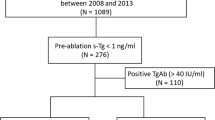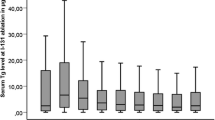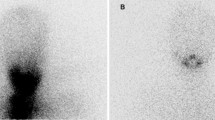Abstract
Aim: To determine the effect of levothyroxine (L-T4) therapy on the recurrence rate of nodular disease in patients previously treated with lobectomy for benign nodular goiter. Methods: Two hundred and thirty-tree patients (38 males, 195 females; age 49.9±13.1 yr) with no post-surgical evidence of nodular disease in the remnant, were followed-up yearly with serum TSH and ultrasound (US). Nodular recurrence was defined as a lesion of at least 5 mm at US. Patients were divided in 2 groups based on whether or not they had been treated with L-T4 after surgery: Group 1 (45 patients) who did not receive any L-T4, and Group 2 (188 patients) treated with L-T4. Group 2 was further subdivided in Group 2a (123 patients) receiving L-T4 substitutive therapy (TSH≥0.5 and ≤3 mUI/l) and Group 2b (65 patients) receiving L-T4 at TSH-suppressive dose (TSH<0.5 mUI/l). Results: Mean observation period was 5.8±4.7 yr. Overall, 71 out of 233 (30.5%) patients experienced recurrence of thyroid nodular disease: 29 patients (64.4%) in Group 1, 24 (19.5%) patients in Group 2a, and 18 (27.7%) patients in Group 2b. The recurrence rate was significantly lower (p<0.001) in Group 2 compared with Group 1, but no significant difference was observed between Groups 2a and 2b. Conclusion: In patients who have undergone hemithyroidectomy for benign monolobar nodular disease, L-T4 therapy may prevent recurrence of nodular disease. TSH suppression may not be required for prevention of recurrence in the remnant thyroid tissue.
Similar content being viewed by others
References
Miccoli P, Antonelli A, lacconi P, Alberti B, Gambuzza C, Baschieri L. Prospective, randomized, double-blind study about effectiveness of levothyroxine suppressive therapy in prevention of recurrence after operation: result at the third year of follow-up. Surgery 1993, 114: 1097–101.
Bistrup C, Nielsen JD, Gregersen G, Franch P. Preventive effect of levothyroxine in patients operated for non toxic goitre: a randomized trial of one hundred patients with nine years follow-up. Clin Endocrinol (Oxf) 1994, 40: 323–7.
Hegedüs L, Nygaard B, Hansen JM. Is routine thyroxine treatment to hinder postoperative recurrence of non-toxic goiter justified? J Clin Endocrinol Metab 1999, 84: 756–60.
Gaitan E, Nelson NC, Poole GV. Endemic goiter and endemic thyroid disorders. World J Surg 1991, 15: 205–15.
Perrild H, Hansen JM, Hegedüs L, et al. Triiodiothyronine and thyroxine treatment of diffuse non-toxic goitre evaluated by ultrasonic scanning. Acta Endocrinol (Copenh) 1982, 100: 382–7.
Hegedüs L, Hansen JM, Veiergang D, Karstrup S. Does prophylactic thyroxine treatment after operation for non-toxic goitre influence thyroid size? Br Med J (Clin Res Ed) 1987, 294: 801–3.
Röjdmark J, Järhult J. High long term recurrence after subtotal thyroidectomy for nodular goitre. Eur J Surg 1995, 161: 725–7.
Krouse RS, McCarty T, Weiss LM, Wagman LD. Postoperative suppressive therapy for thyroid adenomas. Am Surg 2000, 66: 751–5.
Bergfelt G, Risholm L. Postoperative thyroid hormone therapy in non toxic goitre. Acta Chir Scand 1963, 126: 531–7.
Anderson PE, Hurley PR, Rosswick P. Conservative treatment and long-term prophylactic thyroxine in the prevention of recurrence of multinodular goiter. Surg Gynecol Obstet 1990, 171: 309–14.
Ibis E, Erbay G, Aras G, Akin A. Postoperative goitre recurrence rate in Turkey. Acta Endocrinol (Copenh) 1991, 125: 33–7.
Rotondi M, Amato G, Del Buono A, et al. Postintervention serum TSH levels may be useful to differentiate patients who should undergo levothyroxine suppressive therapy after thyroid surgery for multinodular goiter in a region with moderate iodine deficiency. Thyroid 2000, 10: 1081–5.
Dumont JE, Lamy F, Roger P, Maenhaut C. Physiological and pathological regulation of thyroid cell proliferation and differentiation by thyrotropin and other factors. Physiol Rev 1992, 72: 667–97.
Stanbury JB, Brownell GL, Riggs DS, Perinetti H, Itoiz J, Del Castillo EB. Endemic goiter. The adaption of man to iodine deficiency. Cambridge, MA: Harvard University Press, 1954.
Boyages SC. Clinical review 49: Iodine deficient disorders. J Clin Endocrinol Metab 1993, 77: 587–91.
Delange F. The disorders induced by iodine deficiency. Thyroid 1994, 4: 107–28.
Ollis CA, Hill DJ, Munro DS. A role for insulin like growth factor 1 in the regulation of human thyroid cell growth by thyrotropin. J Endocrinol 1989, 123: 495–500.
Eggo MC, Bachrach LK, Burrow GN. Interaction of TSH, insulin and insulin-like growth factors in regulation thyroid growth and function. Growth Factors 1990, 2: 99–109.
Cheung NW, Lou JC, Boyages SC. Growth hormone does not increase thyroid size in the absence of thyrotropin: a study in adults with hypopituitarism. J Clin Endocrinol Metab 1996, 81: 1179–83.
Asmis LM, Kaempf J, Von Gruenigen C, Kimura ET, Wagner HE, Studer H. Acquired and naturally occurring resistance of thyroid follicular cells to the growth inhibitory action of transforming growth factor beta 1 (TGFβ1). J Endocrinol 1996, 149: 485–95.
Thompson SD, Franklyn JA, Watkinson JC, Verhaeg JM, Sheppard MC, Eggo MC. Fibroblast receptors 1 and 2 and FGF receptor 1 are elevated in thyroid hyperplasia. J Clin Endocrinol Metab 1998, 83: 1336–41.
Parma J, Duprez L, Van Sande J, et al. Somatic mutations in the thyrotropin receptor gene cause hyperfunctioning thyroid adenomas. Nature 1993, 365: 649–51.
Russo D, Arturi F, Suarez HG, et al. Thyrotropin receptor gene alterations in thyroid hyperfunctioning adenomas. J Clin Endocrinol Metab 1996, 81: 1548–51.
Lyons J, Landis CA, Harsh G, et al. Two G protein oncogenes in human endocrine tumors. Science 1990, 249: 655–9.
Bos JL. Ras oncogenes in human cancer: a review. Cancer Res 1989, 49: 4682–9.
Karga H, Lee JK, Vickery AL Jr, Thor A, Gaz RD, Jameson JL. Ras oncogene mutations in benign and malignant thyroid neoplasms. J Clin Endocrinol Metab 1991, 73: 832–6.
Tunbridge WM, Evered DC, Hall R, et al. The spectrum of thyroid disease in a community: the Whickham survey. Clin Endocinol (Oxf) 1977, 7: 481–93.
Brander A, Viikinkoski P, Nickels J, Kivisaari L. Thyroid gland: US screening in a random adult population. Radiology 1991, 181: 683–7.
Ezzat S, Sarti DA, Cain DR, Braunstein GD. Thyroid incidentalomas. Prevalence by palpation and ultrasonography. Arch Intern Med 1994, 154: 1838–40.
Tan GH, Gharib H, Reading CC. Solitary thyroid nodule. Comparison between palpation and ultrasonography. Arch Intern Med 1995, 155: 2418–23.
Reeve TS, Delbridge L, Brady P, Crummer P, Smyth C. Secondary thyroidectomy: a twenty year experience. World J Surg 1998, 12: 449–53.
Levin KE, Clark AH, Duh QY, Demeure M, Siperstein AE, Clark OH. Reoperative thyroid surgery. Surgery 1992, 111: 604–9.
Mårtensson H, Terins J. Recurrent laryngeal nerve palsy in thyroid gland surgery related to operation and nerve at risk. Arch Surg 1985, 120: 475–7.
Berglund J, Bondesson L, Christensen SB, Larsson AS, Tibblin S. Indications for thyroxine therapy after surgery for non-toxic benign goitre. Acta Chir Scand 1990, 156: 433–8.
Berglund J, Aspelin P, Bondeson AG, et al. Rapid increase in volume of the remnant after hemithyroidectomy does not correlate with serum concentration of thyroid stimulating hormone. Eur J Surg 1998, 164: 257–62.
Uzzan B, Campos J, Cucherat M, Nony P, Boissel JP, Perret GY. Effects on bone mass of long term treatment with thyroid hormones: a meta-analysis. J Clin Endocrinol Metab 1996, 81: 4278–89.
Faber J, Galløe AM. Changes in bone mass during prolonged subclinical hyperthyroidism due to L-thyroxine treatment: a meta-analysis. Eur J Endocrinol 1994, 130: 350–6.
Baldini M, Gallazzi M, Orsatti A, Fossati S, Leonardi P, Cantalamessa L. Treatment of benign nodular goitre with mildly suppressive doses of L-thyroxine: effects on bone mineral density and on nodule size. J Intern Med 2002, 251: 407–14.
Yavuz DG, Yazici D, Toprak A, et al. Exogenous subclinical hyperthyroidism impairs endothelial function in nodular goiter patients. Thyroid 2008, 18: 395–400.
Biondi B, Fazio S, Cuocolo A, et al. Impaired cardiac riserve and exercise capacity in patients receiving long-term thyrotropin suppressive therapy with levothyroxine. J Clin Endocrinol Metab 1996, 81: 4224–8.
Gharib H, James EM, Charboneau JW, Naessens JM, Offord KP, Gorman CA. Suppressive therapy with levothyroxine for solitary nodules. A double-blind controlled clinical study. N Eng J Med 1987, 317: 70–5.
Cheung PS, Lee JM, Boey JH. Thyroxine suppressive therapy of benign solitary nodules: a prospective randomized study. World J Surg 1989, 13: 818–21.
Derwahl M, Broecker M, Kraiem Z. Clinical review 101: Thyrotropin may not be the dominant growth factor in benign and malignant thyroid tumors. J Clin Endocrinol Metab 1999, 84: 829–34.
Niepomniszcze H, Garcia A, Faure E, et al. Long-term follow-up of controlateral lobe in patients hemithyroidectomized for solitary follicular adenoma. Clin Encocrinol (Oxf) 2001, 55: 509–13.
Bellantone R, Lombardi CP, Boscherini M, et al. Predictive factors for recurrence after thyroid lobectomy for unilateral non-toxic goiter in an endemic area: results of a multivariate analysis. Surgery 2004, 136: 1247–51.
Author information
Authors and Affiliations
Corresponding author
Rights and permissions
About this article
Cite this article
Alba, M., Fintini, D., Lovicu, R.M. et al. Levothyroxine therapy in preventing nodular recurrence after hemithyroidectomy: A retrospective study. J Endocrinol Invest 32, 330–334 (2009). https://doi.org/10.1007/BF03345722
Accepted:
Published:
Issue Date:
DOI: https://doi.org/10.1007/BF03345722




